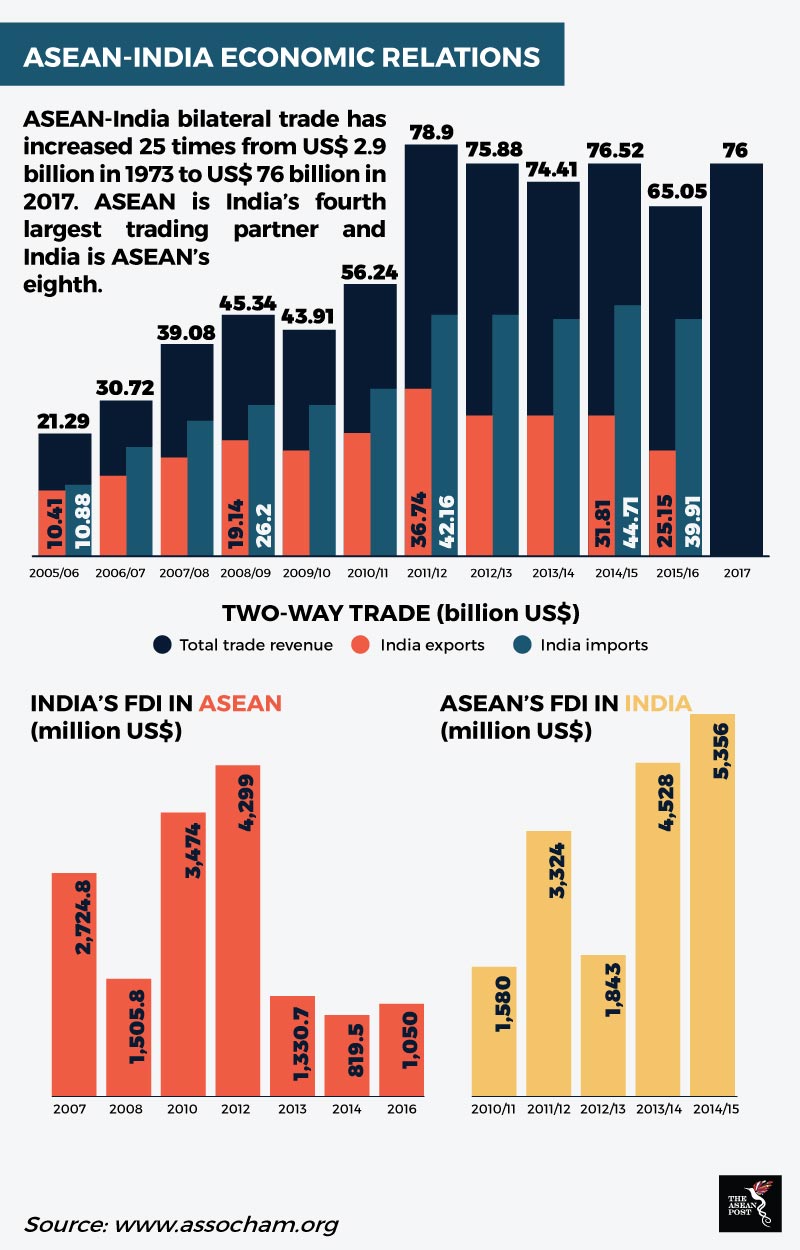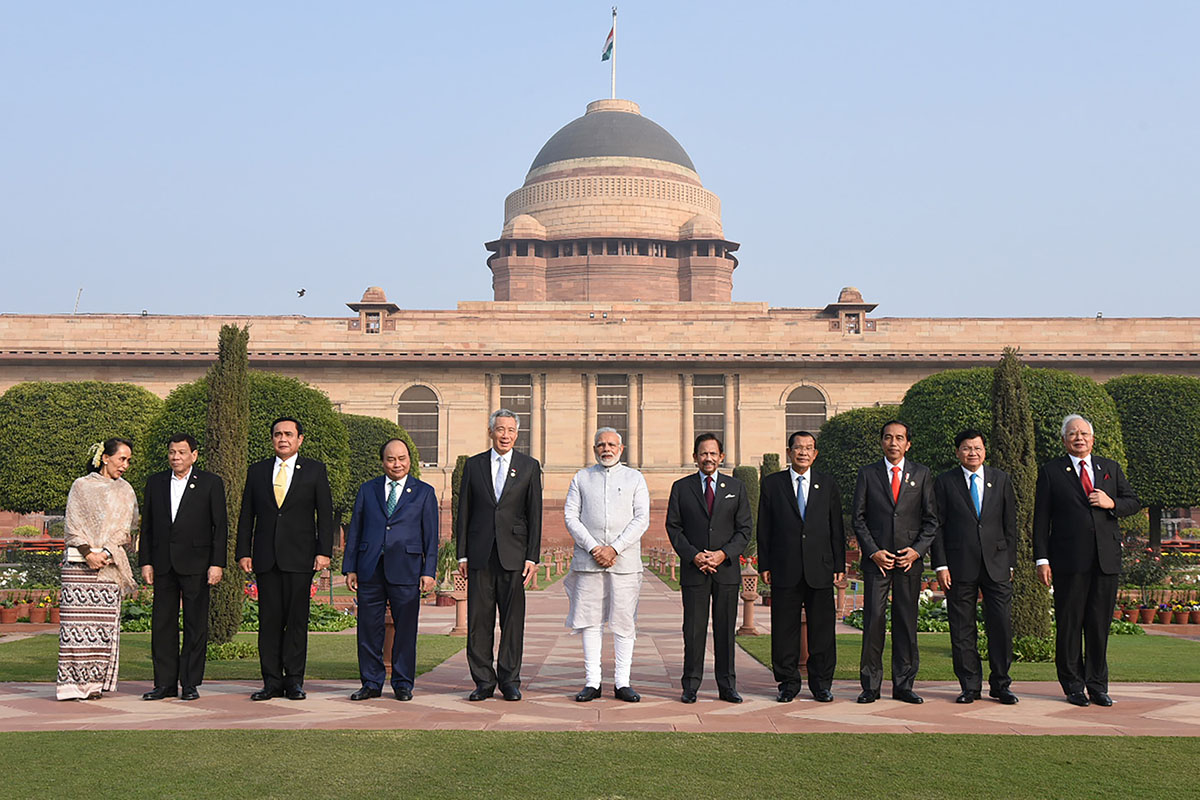The Southeast Asian region and India have civilisational, cultural and linguistical linkages stretching back almost two thousand years. Evidences of Indian influence still permeates the traditions, languages and architectural designs found in many member states of the Association of Southeast Asian Nations (ASEAN).
In the 21st century, ties between India and this region have evolved in line with the current speed and vigour of globalisation. No longer can both parties base their relations on the suzerain structures of the previous millennia. In modern times, trade digits, bilateral agreements and multilateral diplomatic avenues rule the day.
Trade and investment have been growing steadily for the past 25 years since India and ASEAN established sectoral dialogue relations. According to statistics by the ASEAN Secretariat, bilateral trade has grown more than twentyfold from US$2.9 billion in 1993 to US$58.5 billion in 2016. ASEAN is India’s fourth largest trading partner and India is ASEAN’s eighth.
However, in the bigger picture, India still pales in comparison to ASEAN’s other suitor – China which enjoys the largest share of total trade with ASEAN amongst other partner countries at 15.2 percent. In contrast, India’s share is six times smaller at just 2.5 percent.
India recognises the potential of ASEAN as a growing market and amid China’s carrots of investment for ASEAN member states, has upped the tempo of its own diplomatic agenda. India’s intentions with ASEAN is as clear as day. Geographically, ASEAN member states lie between the elephant (India) and dragon (China). Hence, the first to “conquer” Southeast Asia would have considerable geostrategic advantage over the other.

“Conquering” Southeast Asia
To “conquer” in this sense is to have ASEAN within one’s orbit of influence. ASEAN’s relative consistency in upholding the principle of centrality demonstrates that this isn’t going to be easy.
But Modi is up to the task.
Undergirded by the Act East Policy, he has envisioned a future for India as the foremost power in the region – acting as a countervailing force to the rise of China. The policy – just as its name suggests – looks towards intensifying cooperation with eastern countries especially Southeast Asian nations which Modi has previously stated are at the “centre of our engagement.”
Under New Delhi’s Make in India initiative, companies in Southeast Asia can unlock immense investment potential in fields like construction, aviation, food processing and energy – just to name a few. As India positions itself as a global manufacturing hub, ASEAN can complement this, as its vast market potential with over 640 million citizens makes this region an irresistible export destination. Moreover, as the Chinese Yuan continues to strengthen, Chinese labour costs have increased and India is poised to take advantage of that. Wages in the manufacturing sector has flatlined to US$1 since 2010. Cheaper Indian labour is also an attractive investment for financially better off ASEAN member states like Singapore and Brunei.
Besides that, India has been working hard to ensure a comfortable business environment for foreign investors. India recently climbed 30 places in the World Bank Ease of Doing Business Index last year – the largest jump by any country in the index. In the past two years, it has moved up 32 places in the World Economic Forum Global Competitiveness Index. It also ascended 21 places on the World Intellectual Property Organisation (WIPO) Global Innovation Index in the past two years.
The buck however, does not stop there.
There is still the Regional Comprehensive Economic Partnership (RCEP) which is a crucial multilateral trade avenue that ASEAN and India can engage in. India’s commitment to the RCEP would boldly showcase its obligation towards better economic ties with the bloc. So far, India has been hesitant to liberalise its goods sector but during a recent summit with ASEAN leaders, it agreed “toward the swift conclusion of a modern, comprehensive, high quality, and mutually beneficial RCEP.”
Besides that, ASEAN and India must work hand in hand to ensure better connectivity between the two in terms of maritime, air and land routes. The proposed India-Myanmar-Thailand trilateral highway is still in negotiations. In comparison, China’s railroad linkage from Kunming to Singapore is already being partly constructed. Outstanding proposals on bettering ASEAN-India air connectivity and maritime transport have to be expediated if India wishes to be on par with China’s level of engagement with this region.
Relations between ASEAN and India are now at an all time high and both sides stand to gain from this increased level of cooperation. For India however, it has to check China’s charm offensive with measures of its own – and do so with haste.
Recommended stories:
